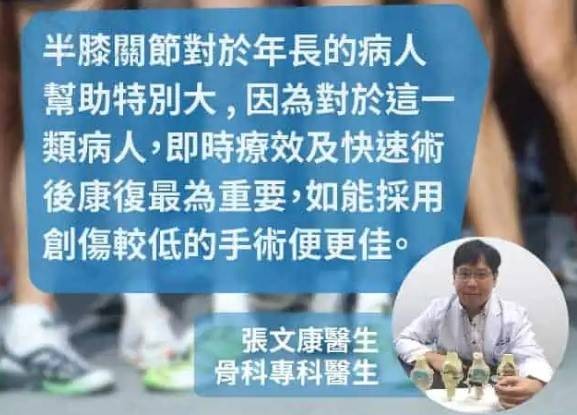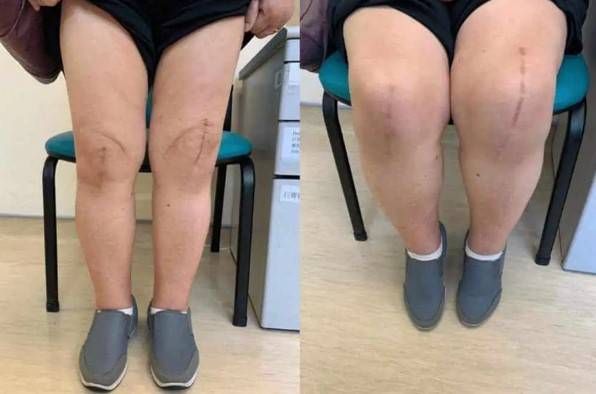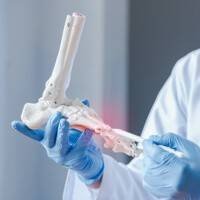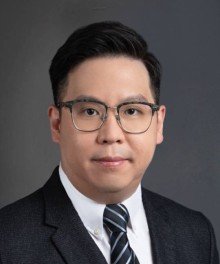
The human body is like a machine; over time, its parts wear out, especially weight-bearing joints like the knees, which are more prone to wear and tear. For those suffering from severe degenerative knee arthritis, the resulting pain and joint deformities can hinder daily activities, often requiring aids like canes or walkers, making it necessary to consider knee replacement surgery, In recent years, a new concept and technology known as "Oxford Knee" has been introduced locally for partial knee replacements. This method is less traumatic than total knee replacements, allows for faster recovery, and offers a better range of motion compared to total artificial knees, enabling some patients who were previously deemed unsuitable for surgery to undergo partial knee replacement.
Knee replacement surgeries can be categorized into total knee replacements (TKR) and partial knee replacements or unicompartmental knee replacements (UKR). The former involves replacing the entire knee joint with an artificial joint, while the latter only replaces the damaged part, preserving normal tissues like the cruciate ligaments and meniscus.
Orthopedic specialist Dr. Cheung Man Hong pointed out that up to 90% of patients experience wear concentrated on the inner side of the knee joint. In principle, if only this part is replaced while maintaining normal ligament structures, the joint's mobility will be higher, leading to smoother walking. However, the traditional criteria for selecting patients for partial knee replacement are very strict, resulting in only a small number of patients being eligible. The introduction of the Oxford Knee has relaxed these criteria: as long as patients have normal ligament function and wear is on the inner side, they may qualify to undergo UKR surgery.
Dr. Cheung noted that previously only about 8% of patients needing knee surgery were suitable for partial knee replacement, but the Oxford Knee has increased this rate to 44%. For instance, at Queen Mary Hospital, the number of patients undergoing partial knee replacement has risen from just a few to over 30 in the past two years.
Using the example of a 75-year-old woman with severe degenerative arthritis, whose knee joints were deformed with more than 20 degrees and 15 degrees of bending respectively, traditional concepts would deem her unsuitable for partial knee surgery. However, using the Oxford Knee allowed for a simultaneous replacement of both knees, correcting the deformed joints with results comparable to total knee replacement, significantly enhancing her mobility.
Dr. Cheung emphasized that if both knees require total knee replacement, the significant surgical trauma means both surgeries need to performed separately, requiring two recovery periods and prolonging the patient’s suffering. In contrast, partial knee surgery is less traumatic, with incisions as short as 6 cm—one-third of a total knee surgery. The amount of bone tissue removed and blood loss is also less, allowing for simultaneous replacement of both knees.

Comparing the wounds from total knee replacement (left) and partial knee replacement (right), the incision for the partial knee replacement is noticeably shorter.
He also mentioned that patients undergoing partial knee replacement generally recover faster. With proper management, up to 90% of patients can stand on the same day or the next day post-surgery, and some patients may even walk back to their rooms independently. This boosts their confidence in recovery, and even if they experience bruising or pain, they know they are healing and can walk normally again.
In recent years, advancements in orthopedic surgery have utilized 3D printing technology, computer navigation, and robotic arms. Dr. Cheung stated that while robotic arms can improve accuracy, their high costs limit their use. In contrast, the Oxford Knee can be performed with standard equipment already available in public or private hospitals in Hong Kong, making it suitable for broader local application. However, the Oxford Knee surgery requires higher technical skills from the doctors, as the procedure is more challenging than total knee replacements. The incisions are smaller, requiring precise angles when cutting bone while considering normal tissue, and the polyethylene liner placed within the joint must be accurately positioned to avoid loosening, which could affect joint movement.
Although partial knee replacement is less traumatic, it is not suitable for every patient. Those with extensive joint degeneration, abnormal ligament function, rheumatoid arthritis, gouty arthritis, or other health conditions may not be eligible.
Dr. Cheung believes that partial knee replacement offers significant benefits for older patients, as immediate effectiveness and rapid post-operative recovery are crucial. If a less traumatic surgical option is available, it would be a better choice for this group of patient. Clinically, he has observed that some patients who were traditionally considered unsuitable for partial knee replacement have achieved results after the Oxford Knee that are comparable to total knee replacement
He concluded by stating that the concept of partial knee replacement using the Oxford Knee was first proposed by experts from the University of Oxford in the 1980s and has been in use globally for over thirty years. Local follow-up studies show that most patients who undergo partial knee surgery do not require another surgery later on.




















